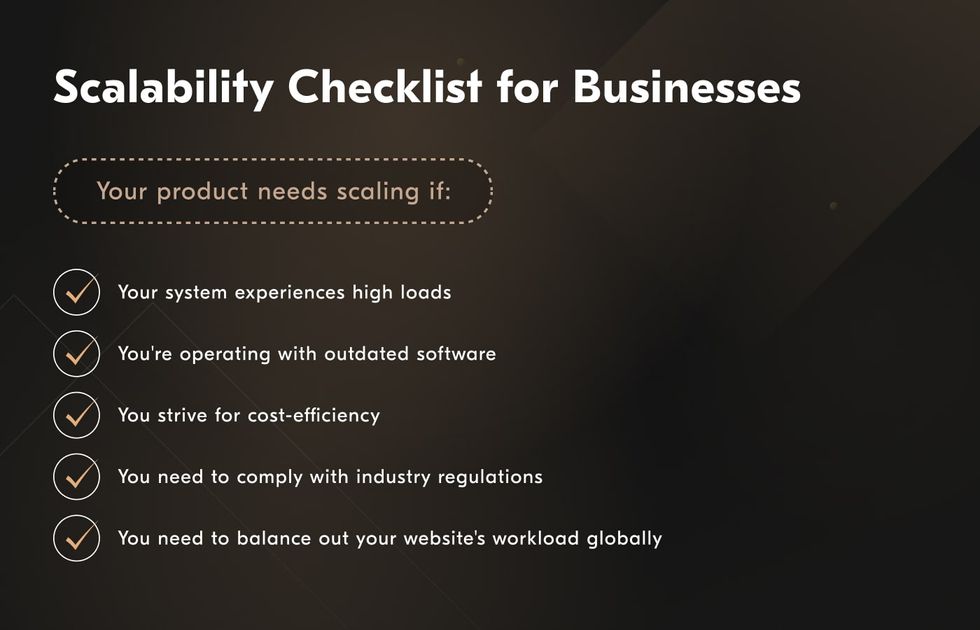
Key Takeaways
- Scaling a web application enables improved performance, high availability, flexibility, and adaptability. The core goal is to handle growth and future needs.
- However, when scaling your app, you may face several issues. They include database inefficiency, server issues, code failures, lack of automation, poor traffic distribution, and load problems.
- Scaling your web application is crucial when you experience high loads, plan to migrate to the cloud for modernization, or seek time and cost savings through pre-built server solutions. Also, you may need it to comply with specific regulations.
When building or modernizing a web application, consider every critical factor that impacts its success. Scalability is one of the first on the list.
Even if your product is at the early development lifecycle stage, you should be forward-thinking. Web apps often experience rapid growth. So, shortly after the launch, requests per minute (RPM) may significantly increase. Your application must be ready to withstand these changes and meet high expectations.
If your web app isn’t ready to handle increasing user loads, it leads to slow response times, poor user experience, and increased bounce rates. Almost half of website users (47%) won’t wait more than two seconds for a website to load.
In turn, coping with a growing customer flow and an expanded audience will take your business to the next level. However, efficient web scaling is quite a complex task. It requires considerable time, money, and resource investments. Moreover, many are unaware of the best web product scaling methods and the challenges they could face in progress.
For example, 65% of digital leaders use low-code approaches to ensure their software scalability. At the same time, there’s an annual 35% increase in cloud computing investments due to its flexibility in terms of scaling. Do you want to learn about these and other effective methods to make your web app robust and future-proof? Find the answers to this question and even more in this post.

We at Acropolium have gained a rich 20±year expertise in SaaS development, cloud solutions, and web application modernization. Drawing on our team’s experience, we will introduce the key challenges, efficient solutions, and benefits of application scaling. Also, you will learn from our enterprise construction management, biotech SaaS, and multi-tenant accounting automation case studies.
What is Application Scalability?
Application scalability is the capacity of an application to handle growing loads, users, or data without compromising performance or reliability. A scalable design accommodates increased demand by adding resources like servers, databases, or bandwidth, ensuring seamless functionality even under high workloads or unexpected issues.
Since databases are integral to application architecture, their scalability must be addressed early. Database scalability ensures a system can manage more data and users while maintaining performance and data integrity. This can be achieved by scaling vertically (adding resources to a single server) or horizontally (distributing workloads across multiple servers).
Understanding the Importance of Scaling a Web Application
Application scaling involves optimizing the app’s architecture, infrastructure, and resources. It aims at handling the increased load without compromising performance, reliability, and user experience.
Due to Boston Consulting Group, scalability brings companies 3x higher ROI, 15-20% revenue growth, and 15-20% cost savings.
At Acropolium, we ourselves witnessed companies reimagine their operations by investing in scalability. For example, by adopting a cutting-edge cloud platform for real-time tracking and balanced data distribution, our supply chain client saw a 25% increase in overall efficiency.

Now, let’s overview several most compelling reasons why scaling is crucial:
- Forget about performance bottlenecks, latency issues, and slowdowns. Thanks to scaling, a web application maintains optimal performance even as the user base and traffic grow.
- Implement redundancy and fault-tolerant mechanisms, such as load balancing and clustering. They ensure the application remains accessible even if individual servers or components fail.
- During peak usage periods, scaling websites enables them to handle the temporary surge in traffic without negatively impacting performance. Similarly, scaling down during lower demand periods optimizes resource utilization and cost efficiency.
- With scaling, businesses seamlessly introduce new features, accommodate increased data storage requirements, and support additional user interactions.
The Most Common Problems with the Scalability of Web Applications
The complexity and cost of scaling a web application depend on many factors. The potential issues may come from any side. So be ready to address them right away. Here’s a list of the most common challenges to watch out for:
- Database inefficiency. A robust and resistant database is necessary when scaling a web app. The issues may arise because of choosing the wrong database engine. Another risk is providing several databases to cope with queries’ growth. The most reliable solution to this problem is using replication and sharding methods. Replication ensures that data is handled on multiple databases simultaneously. In turn, sharding segments data to avoid handling it in one place.
- Server issues. Server overloads are mainly caused by increased RPM and the number of connected users. If your server fails, it results in poor system performance and quality. Turn to vertical or horizontal scaling or combine these methods to strengthen your server — just what we did to help our client handle a growing number of users for their conferencing app.
- Unscalable architecture. Applications built on unscalable architectures face significant challenges when handling growth. Monolithic structures and tightly coupled components can hinder performance as demand increases. Transitioning to modular or microservices architectures can improve scalability by isolating workloads and enabling independent updates or scaling of components.
- Resource constraints. Resource limitations — including insufficient CPU, RAM, or bandwidth — can severely impact an app’s ability to scale. These constraints are often exacerbated by outdated infrastructure or poor initial resource allocation. Addressing these issues involves upgrading hardware, leveraging cloud solutions, or implementing dynamic resource management techniques like autoscaling.
- Code failures. Clean code and consistent architecture are the essentials of your app scalability. Any issues regarding your app’s frontend or backend may lead to disaster. To prevent it, you ensure your tech partners constantly check the code quality, test the product, and maintain relevant documentation.
- Lack of automation. Traditional on-premises solutions may cause various mistakes regarding your app’s scalability and maintenance. Manual errors are nearly inevitable. In contrast, turning to cloud backend solutions automates many processes. Thus, depending on your current needs, you can scale your web application up or down.
- Poor traffic distribution. Inefficient server management often triggers traffic distribution and balance problems. Sharing traffic between multiple servers is complex. That’s why it’s worth using several traffic balancers, reducing the risks if one fails.
- Load problems. Although high website traffic proves your app’s success, it also causes particular issues. Querying millions of simultaneous visitors is pretty challenging. So one of the primary goals of a scalable web application is to build a robust system to handle high traffic. In most cases, caches are the most effective solution to such issues. They reduce database queries and improve the loading speed.
To minimize these risks and guarantee a smooth scaling process, try DevOps services from a reliable vendor like Acropolium.
How to Successfully Scale Your Web App
Successful app scaling is a complex process that concerns most app elements. They include databases, modern architecture, code quality, loading speed, servers, and more.
To choose the right approach, prioritize your app’s specifics and address the performance issues it’s experiencing. Outdated code, unreliable databases, and insufficient loading speed require implementing specific scaling methods.
Here are the most efficient and popular ways to improve your application’s scalability.
Cloud Computing
According to Statista, most respondents (56%) claim better scalability as the most significant driver of cloud-based security solutions.

Full or partial migration will address many scalability issues. It offers secure data storage and overall system performance improvement.
However, here comes an important decision to make. You should choose the horizontal or vertical scaling approach depending on your current needs and the web app’s nature. For example, to achieve scalability in a pharma application, our developers chose Microsoft Azure with AKS for scalable data management, which lowered operational costs.
Vertical Scaling
Vertical scaling increases resources like RAM and CPU on a single server to handle growing user requests. While this provides quick results, it’s a temporary fix. Every server has limits, and resolving future challenges may require significant architectural changes.
Horizontal Scaling
Horizontal scaling adds more servers to distribute workloads, ensuring reliability and scalability without limits. Using ready-made cloud solutions like AWS or Azure simplifies server management and reduces costs.
Autoscaling is a valuable option, automatically adjusting server performance as needed. Load balancers further enhance scalability by efficiently routing traffic between clients and servers.

Database Management
Databases are critical to scaling web applications. A horizontal scaling approach requires an efficient database engine to handle numerous queries. Effective database management uses replication or sharding techniques:
- Replication: Copies data across multiple databases to improve reliability, recovery, and read performance.
- Sharding: Distributes data across smaller databases to increase capacity and reduce strain on a single storage location.
Combining replication and sharding enhances database performance by segmenting and duplicating data.

Cache Configuration
Caching reduces database pressure by storing frequently accessed data in temporary memory. This allows the database to operate faster, as most queries are redirected to the cache first with this web application scalability approach. For example, when users access the app, their requests are handled by the cache unless specific data is missing, minimizing database workload.

Content Delivery Network
Content Delivery Network (CDN) also takes advantage of the cache tires. However, this solution exists for another purpose. CDNs improve frontend scalability by distributing content through a global server network. They process user requests via the nearest server, reducing load times and enhancing performance, especially for content-heavy apps. Providers like AWS CloudFront and Cloudflare offer reliable CDN solutions.

Clean Code
If your code isn’t clean and well-functioning, no advanced solutions make sense when building a scalable app. All app development stages, including the tech stack, product architecture, UX design, and deployment, directly impact your application’s scaling capacity.
That’s why providing constant quality checks and multiple QA testing sessions at all web development stages is vital. Improve algorithms, use appropriate design patterns, and ensure you won’t end up with spaghetti code instead of large scalable websites or apps.
Modularity
Adopting a modular architecture can significantly improve scalability by breaking the application into independent, self-contained modules. Each module handles specific tasks or functions and communicates with others through defined interfaces. This approach offers several advantages:
- Modules can be scaled individually based on demand, ensuring efficient resource utilization.
- Modular design isolates issues, making it easier to debug and update components without affecting the entire system.
- Modules can be reused across different projects or adapted for new functionalities, reducing development time and costs.
Architecture Pattern
When building a plan on how to scale application, pay extra attention to choosing the proper architectural pattern. It has a great impact on an application’s scalability. The preliminary choice depends on the product’s nature, goals, market, industry demands, and more.
Here are the most widespread architecture types suitable for scalable web applications.
- Layered architecture. This pattern consists of multiple data layers. Apps with such an architecture are often hard to scale since they don’t involve multiple servers and databases.
- Event-driven architecture. This pattern depends on specific events (state changes) that trigger the data shifts and interactions.
- Microkernel (plug-in) architecture. Such architecture involves a minimal core operating system you can enrich by adding more functions. It ensures a clear distinction between primary and additional features.
- Microservices architecture. This architecture consists of multiple modules that don’t depend on each other. So you can develop, deploy, and change some aspects of the app without changing the entire scaling application.

Security Considerations in Scaling
To scale applications, consider several core aspects:
- Implement user authentication and role-based access controls.
- Use secure protocols and encryption for data protection.
- Strengthen network security with firewalls and intrusion prevention systems.
- Follow secure coding practices to avoid vulnerabilities like improper input validation.
- Prepare an incident response plan for quick detection and resolution of security incidents.
- Regularly perform backups and test recovery processes.
- Evaluate third-party components’ security and ensure compliance with industry regulations like GDPR or HIPAA.
Does Your Business Really Need the Scalability of a Web Application?
As you see, reaching web application scalability is a complex task requiring significant time and resource investments. So, before starting such a challenging project, decide if your product should be scalable.
First, determine whether your web app will experience significant user traffic and increased load. If your website has a few hundred users and their number isn’t likely to grow in the foreseeable future, a large-scale solution may be an unnecessary waste of time and money.
Also, the decision to scale is hasty for those running startups at early lifecycle stages. In such cases, your primary goal is to bring your product to the market and verify its capacity. After a while, your web application will likely hit the target and expand the audience. Then, you may consider scaling an actual prospect for your company’s business growth.
However, application scalability is often not a prospect but an immediate need.
Here is the list of situations where scaling opens up new opportunities for your web platform or solves its current challenges.
- Your system experiences high loads.
- Your web application is outdated, and you’re considering migrating to the cloud.
- You want to save time and cost with the ready-made server, database, and API solutions.
- The app must comply with specific regulations.
- Your need to regulate and balance your website’s workload, serving end-users around the globe equally well.
If any of these statements are true for you, scaling is your best (or even the only) way out.
The following case studies will help you better understand when web application scalability benefits businesses and how to implement such solutions efficiently.
Acropolium’s Case Studies
Acropolium is a reliable software vendor with rich experience in SaaS development, cloud solutions, and web app modernization. Also, we provide DevOps, facilitating the necessary processes, tools, and practices. This approach supports the scaling efforts and helps avoid potential issues.
Our dedicated team empowers companies to adapt and meet market demands through highly scalable solutions. We work with startups, small and mid-sized businesses, and enterprises, offering options for every need and budget.
We understand the specifics of custom software development, even in the most complicated industries. These include healthcare, retail, fintech, risk management, supply chain, and logistics. Let’s look at some examples of bespoke software solutions for individual projects.
Enterprise Construction Management Software
In this project, our company needed to provide the client with the optimization of a huge enterprise construction management software. We aimed to modernize particular software modules and use new frontend and backend technologies. Also, we needed to make the product scalable and add more features.
As a result, our developers scaled the system and increased its working speed by 60%. We also migrated the core modules to new technologies and provided efficient documentation of all sub-systems. Finally, we modernized the frontend side and optimized the project management system.
Biotech Enterprise SaaS Development
We implemented a biotech enterprise SaaS solution to automate and streamline workflows. It reduced administrative expenses and the workforce required for asset auditing, certification, and quality control.
With improved client-to-client and client-vendor communication, the client experienced a 30% increase in new customers. Also, we witnessed a remarkable 65% increase in sales and a 75% boost in customer loyalty, thanks to the user-friendly dashboard and administrative panels.
Accounting Software for Financial Business
Within five months, we successfully developed a reliable for small businesses, accountants, and bookkeepers. With our solution, users can set up accounts in five clicks. It facilitates transactions, tracking, payments, and report generation.
Following the release of our MVP accounting software, we achieved a remarkable 30% conversion rate from free demos to paid plans. This result indicates strong user interest and satisfaction.
Final Thoughts
With constant innovations and robust technologies, businesses have numerous options for scaling web applications. The cloud-based approaches are even more cost-efficient than on-premises ones. At the same time, the solutions they offer are future-proof and reliable. With multiple servers, secure databases, and scaling automation, you can find the most effective way to build a powerful and durable system.
Looking for an experienced tech partner to choose the right way to scale up application? We at Acropolium could be a perfect match. Our team members are experts in finding scalable solutions. We managed numerous projects regarding process automation and full system modernization. Our products are easy to scale on cloud architecture, depending on your business growth.
So if you have any questions or ideas concerning your web app’s scalability, feel free to drop us a line and try our expert IT outsourcing on a subscription basis. Let’s start the journey to your app’s large-scale future together!










![Discovery Phase in Software Development: [Benefits, Steps & Team Roles]](/img/articles/discovery-phase-in-software-development-benefits-steps-and-team-members/img01.jpg)

![E-commerce App Development: [2025 Guide]](/img/articles/the-a-z-guide-to-e-commerce-app-development-benefits-features-and-cost/img01.jpg)
![Why Do Software Projects Fail [6 Reasons and Solutions]](/img/articles/why-do-software-projects-fail/img01.jpg)
